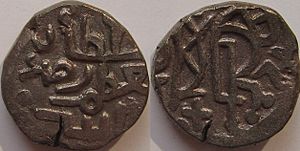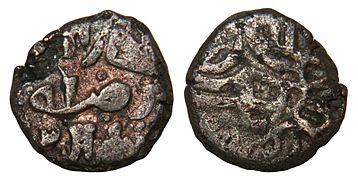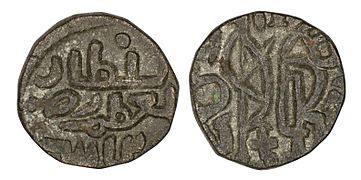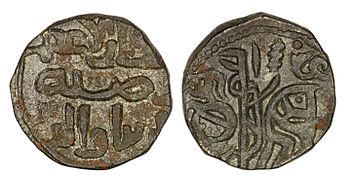Razia Sultana facts for kids
Quick facts for kids Raziyyat-Ud-Dunya Wa Ud-Din |
|||||
|---|---|---|---|---|---|
| Sultan | |||||

Billon jital coin of Razia
|
|||||
| 5th Sultan of Delhi | |||||
| Reign | 1236 − 20 April 1240 | ||||
| Predecessor | Ruknuddin Firuz | ||||
| Successor | Muizuddin Bahram | ||||
| Died | 15 October 1240 Kaithal, Delhi Sultanate |
||||
| Burial | Bulbuli Khana near Turkman Gate, Delhi | ||||
| Spouse | Ikhtiyaruddin Altunia | ||||
|
|||||
| House | Mamluk dynasty | ||||
| Father | Iltutmish | ||||
| Mother | Turkan Khatun | ||||
| Religion | Sunni Islam | ||||
Raziyyat-Ud-Dunya Wa Ud-Din (Persian: سلطان رضیة الدنیا والدین) (died 15 October 1240), often called Razia Sultana, was a powerful ruler of the Delhi Sultanate. This was a large kingdom in the northern part of the Indian subcontinent. She ruled from 1236 to 1240.
Razia Sultana was special because she was the first and only female Muslim ruler of Delhi. She was also the first female Muslim ruler in the entire Indian subcontinent.
She was the daughter of Mamluk Sultan Iltutmish. Razia helped manage Delhi when her father was away fighting in Gwalior from 1231 to 1232. Some stories say her father was so impressed that he chose her to rule after him.
After Iltutmish died, Razia's half-brother Ruknuddin Firuz became king. But his mother, Shah Turkan, was very cruel and planned to harm Razia. During a rebellion against Ruknuddin, Razia spoke to the people of Delhi. She encouraged them to stand up against Shah Turkan.
In 1236, Ruknuddin was removed from power, and Razia became the new Sultan.
Contents
Becoming the Sultan
When Razia became Sultan, some powerful nobles did not like it. They were mostly Turkic leaders. Some of them eventually joined her side, while others were defeated.
The Turkic nobles who supported her thought she would be easy to control. But Razia quickly showed that she was a strong ruler. She started making her own decisions and appointed non-Turkic officers to important jobs. This made the Turkic nobles angry.
In April 1240, a group of nobles removed her from power. She had ruled for less than four years. Razia then married one of the rebels, Ikhtiyaruddin Altunia. Together, they tried to get her throne back.
However, her half-brother and new ruler, Muizuddin Bahram, defeated them in October 1240. Razia was killed shortly after this defeat.
What Her Name Means
Razia's name can also be written as Raḍiyya or Raziyya. The word "Sultana" is sometimes used for her today, but it's not quite right. "Sultana" usually means "the king's wife," not "a female ruler."
On her own coins, Razia called herself Sultan Jalalat al-Duniya wal-Din. This means "Sultan, the Glory of the World and Religion."
Razia's Early Life
Razia was born to Sultan Iltutmish of Delhi. Her father was a Turkic slave (called a mamluk) who became Sultan. Razia's mother was Turkan Khatun, who was the chief wife of Iltutmish.
Razia was the eldest daughter of Iltutmish. She was likely his first child.
How She Became Sultan
Iltutmish had planned for his oldest son, Nasiruddin Mahmud, to rule after him. But his son died unexpectedly in 1229.
A historian named Minhaj-i-Siraj wrote that Iltutmish felt his other sons were too interested in fun. He thought they would not be able to manage the kingdom.
In 1231, Iltutmish went to fight in Gwalior. He left Razia in charge of Delhi. Razia did such a good job that when her father returned, he decided she should be his successor.
Iltutmish even ordered a special document to be written, naming Razia as the next ruler. When his nobles asked why he chose a daughter when he had sons, Iltutmish said Razia was more capable than any of them.
The Nobles' Choice
However, after Iltutmish died, the nobles chose his son, Ruknuddin Firuz, to be the new king. It's possible that Iltutmish might have changed his mind later. He had called Ruknuddin back to Delhi when he became very ill.
Some historians also think the story of Iltutmish choosing Razia might have been spread by her supporters later. The historian Minhaj was not in Delhi when these events happened.
Ruknuddin was not a good ruler. He let his mother, Shah Turkan, control everything. They treated people badly and harmed Iltutmish's popular son Qutubuddin. This made many nobles angry, and they started to rebel.
Shah Turkan even planned to harm Razia in Delhi. But Razia spoke to the people during a public prayer. She convinced them to rise up against Shah Turkan.
A large crowd attacked the royal palace and captured Shah Turkan. Many nobles and the army then supported Razia. They placed her on the throne in 1236. Ruknuddin tried to return to Delhi, but Razia had him arrested. He was likely executed in November 1236, after ruling for less than seven months.
Razia becoming Sultan was very unusual. Not only was she a woman, but the people of Delhi strongly supported her. One old text says she told the people to remove her if she did not meet their hopes.
Challenges to Her Rule
From the start, Razia faced strong opposition from the powerful Turkic nobles. She became Sultan with the help of the people of Delhi, not these powerful governors.
Razia tried to balance the power of the Turkic nobles. She started giving important jobs to non-Turkic nobles. This made the Turkic nobles even more upset.
The prime minister, Nizamul Mulk Muhammad Junaidi, refused to accept her as Sultan. Four other Turkic nobles who had rebelled against Ruknuddin also joined him.
Razia led her army out of Delhi to fight these rebels. After some small battles, two rebel leaders, Muhammad Salari and Izzuddin Kabir Khan Ayaz, decided to join Razia. They secretly met with her and planned to arrest the other rebel leaders.
But the other rebels found out and escaped. Razia's forces chased them. Some rebels were captured and later executed. Junaidi fled to the hills and died there. Another rebel, Alauddin Jani, was killed.
Razia's Time as Sultan
As soon as she became Sultan, Razia made important changes. She appointed Khwaja Muhazzabuddin as her new prime minister. She also gave him the title Nizamul Mulk.
Razia appointed Malik Saifuddin Aibek Bahtu to lead her army. He was given the title Qutlugh Khan. When he died, she appointed Malik Qutubuddin Hasan Ghuri to a new army leadership role.
She gave the region of Lahore to Malik Izzuddin Kabir Khan Ayaz, one of the rebels who had joined her. Razia also gave important positions in her royal household to people she trusted. This included Malik-i Kabir Ikhtiyaruddin Aitigin and Malik Jamaluddin Yaqut.
Historians say that soon, all the nobles from the east to the west accepted her rule.
Military Actions and Challenges
Razia's first military action was against Ranthambore. Its ruler had declared independence after Iltutmish died. Razia sent her army, but they could only rescue the Turkic nobles and officers from the fort. They could not fully defeat the local ruler.
These local rulers, with the help of the Mewatis, took control of a large part of what is now north-eastern Rajasthan. They fought a guerrilla war around Delhi. Razia also sent forces to take back control of Gwalior, but this mission was stopped.
During Razia's rule, a group of Shias rebelled against the Sultanate. But this rebellion was quickly put down. In one big event, a Shia group called the Qarmatians attacked the main mosque in Delhi. Their leader, Nuruddin Turk, had gathered many supporters.
On March 5, 1237, they entered the mosque and started attacking the Sunnis who were there for Friday prayers. But the citizens fought back and stopped them.
In 1238, a governor named Malik Hasan Qarlugh faced a threat from the Mongols. He sent his son to Delhi, probably asking for military help. Razia welcomed the prince but refused to join an alliance against the Mongols.
Razia's Downfall
The nobles who supported Razia wanted her to be just a figurehead, someone who looked like a ruler but had no real power. However, Razia began to show her own strength more and more.
For example, her first coins had her father's name on them. But by 1237–1238, she started issuing coins only with her own name.
At first, she followed purdah, meaning she stayed behind a screen in court. Female guards surrounded her. But later, she started appearing in public dressed in men's clothes, wearing a cloak and a hat. She rode elephants through Delhi, just like the male Sultans before her.
Razia's growing power and her choice to appoint non-Turkic people to important jobs made the Turkic nobles angry. The job of Amir-i Akhur (master of the horses) had always been held by Turkic officers. But Razia gave it to Yaqut, who was from Abyssinia. This made her Turkic officers very upset.
Many historians believe that Razia's close relationship with Yaqut was a major reason for her downfall.
The Rebellion Against Her
In 1238–1239, Malik Izudin Kabir Khan Ayaz, the governor of Lahore, rebelled against Razia. She marched against him and forced him to flee. Since the area beyond was controlled by the Mongols, Izzuddin had to surrender and accept Razia's rule again.
Razia was kind to him. She took Lahore from him but gave him the region of Multan instead.
Razia had brought Ikhtiyaruddin Aitigin, a Turkic slave, back to her court in Delhi. She made him Amir-i Hajib (a high court official). She also favored another slave of Iltutmish, Ikhtiyaruddin Altunia. She gave him important regions to govern.
However, these two officers secretly worked with other Turkic officers to overthrow Razia. This happened while she was away on her Lahore campaign.
Razia returned to Delhi on April 3, 1240. She soon learned that Altunia had rebelled against her in Tabarhinda. Not knowing that other nobles in Delhi had joined Altunia, Razia marched towards Tabarhinda ten days later.
At Tabarhinda, the rebel forces killed her loyal supporter Yaqut and captured her. According to Minhaj, Razia ruled for 3 years, 6 months, and 6 days.
Her Alliance and Death
When the nobles in Delhi heard that Razia was arrested, they appointed Muizuddin Bahram, another son of Iltutmish, as the new Sultan. He officially became king on April 21, 1240.
The nobles expected Bahram to be a figurehead, just like they wanted Razia to be. They created a new powerful position, naib-i mamlakat (like a regent), and gave it to Ikhtiyaruddin Aitigin. However, the new king had Aitigin killed within a couple of months.
After removing Razia, the nobles in Delhi divided important jobs and regions among themselves. They ignored Ikhtiyaruddin Altunia, who had arrested Razia. After Aitigin's death, Altunia realized he wouldn't get much benefit from Razia's overthrow. So, he decided to join forces with her.
Razia also saw this as a chance to get her throne back. She married Altunia in September 1240. Some other unhappy Turkic nobles also supported them.
Altunia gathered an army, which included Khokhars, Jats, and Rajputs. In September–October 1240, Sultan Muizuddin Bahram led his army against Altunia and Razia. He defeated them on October 14, 1240.
Altunia and Razia had to retreat to Kaithal. There, their soldiers left them. They were killed by a local group on October 15, 1240.
Razia Sultana remains the only woman to have ever ruled Delhi as Sultan.
Her Tomb
Razia's grave is in Mohalla Bulbuli Khana, near Turkman Gate in Old Delhi. A traveler from the 14th century, Ibn Batuta, wrote that Razia's tomb became a place of pilgrimage. People built a dome over it and sought blessings there.
It is believed that Razia's half-brother Bahram, who replaced her, built her grave. Another grave next to hers is said to belong to her sister, Shazia. Razia was a follower of the Sufi saint Shah Turkman Bayabani. The place where she is buried is said to be his spiritual center.
Today, the site is not well-maintained. The Archaeological Survey of India does yearly upkeep. However, they cannot make it more beautiful because it is surrounded by illegal buildings. You can only reach it through a narrow, crowded lane. In the late 1900s, local people built a mosque nearby.
There is also a ruined building in Kaithal that some believe is the site of Razia's first grave.
Coins of Razia
Coins from Razia's time are found in silver and billon (a mix of metals). One gold coin in the Bengal style is also known. Silver coins called Tankas were made in both Bengal (Lakhnauti) and Delhi.
At first, she issued coins from Delhi with her father Iltutmish's name. Later, she issued coins only with her own name.
- Razia's jaital's Billon coins
Razia in Films and TV
Many Indian films have shown the story of Razia Sultana.
- Razia Begum (1924) was an Indian silent film.
- Devendra Goel directed Razia Sultana (1961), a Hindi-language film starring Nirupa Roy.
- A famous portrayal was by Hema Malini in the 1983 movie Razia Sultan, directed by Kamal Amrohi.
In 2015, And TV started a TV series called Razia Sultan. It tells the story of Razia's life. Pankhuri Awasthy played Razia, and Rohit Purohit played Altunia.
See also
 In Spanish: Razia Sultan para niños
In Spanish: Razia Sultan para niños






